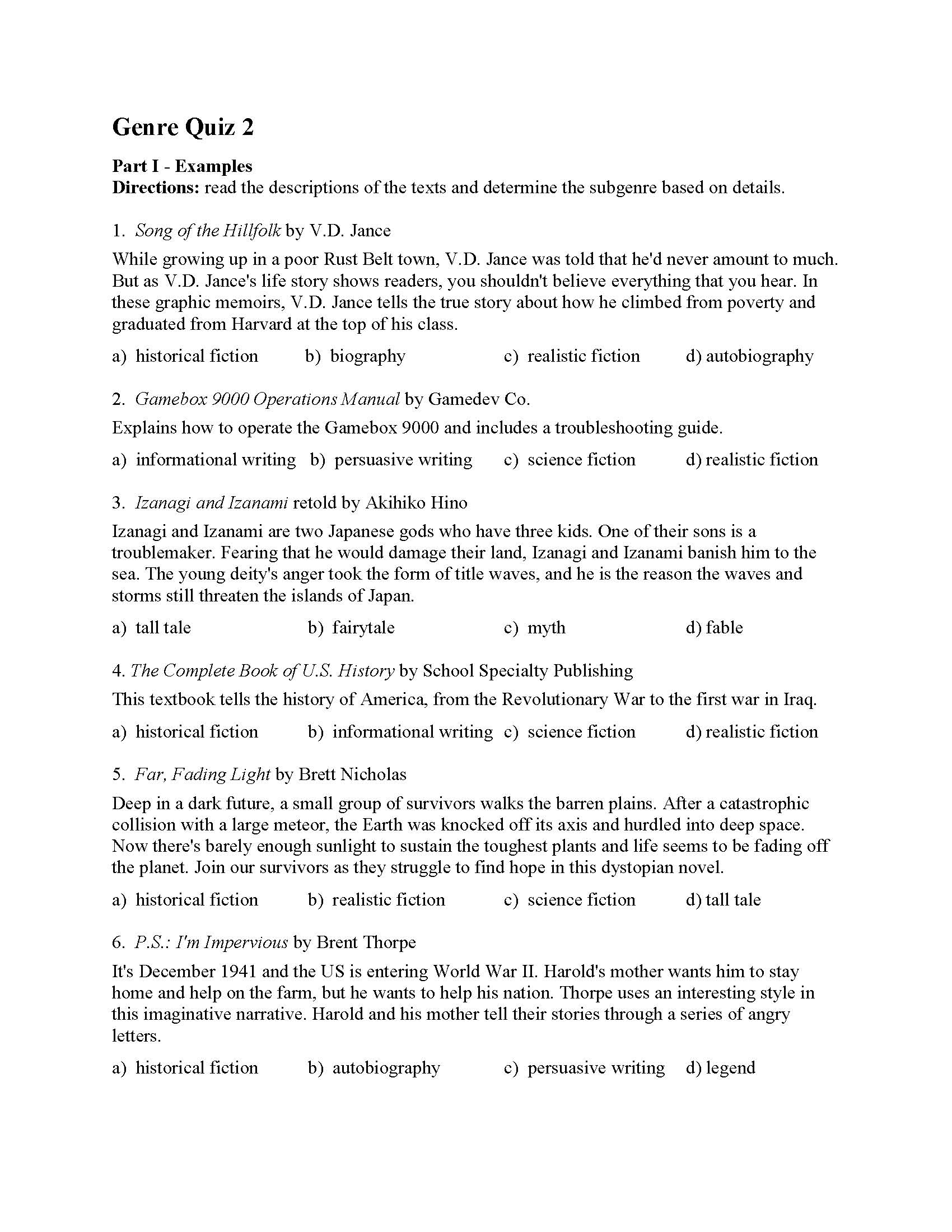Popular Content
Want Email Updates?
Get emails about new stuff.
Be the first to know.
Looking for Something?
Genre Quiz 2
Looking for another genre quiz to assess your students? Check out this genre quiz. It has fifteen multiple-choice questions on literary genres and subgenres. Students identify the genres and subgenres of a variety of texts and then match definitions.
Genre
Common Core State Standards
Genre Anchor Standard
R.9 - Analyze how two or more texts address similar themes or topics in order to build knowledge or to compare the approaches the authors take.RL.K.9 - With prompting and support, compare and contrast the adventures and experiences of characters in familiar stories.
RL.1.9 - Compare and contrast the adventures and experiences of characters in stories.
RL.2.9 - Compare and contrast two or more versions of the same story (e.g., Cinderella stories) by different authors or from different cultures.
RL.3.9 - Compare and contrast the themes, settings, and plots of stories written by the same author about the same or similar characters (e.g., in books from a series).
RL.4.9 - Compare and contrast the treatment of similar themes and topics (e.g., opposition of good and evil) and patterns of events (e.g., the quest) in stories, myths, and traditional literature from different cultures.
RL.5.9 - Compare and contrast stories in the same genre (e.g., mysteries and adventure stories) on their approaches to similar themes and topics.
RL.6.9 - Compare and contrast texts in different forms or genres (e.g., stories and poems; historical novels and fantasy stories) in terms of their approaches to similar themes and topics.
Click to VIEW Grade Level Standards for R.9
R.5 - Analyze how two or more texts address similar themes or topics in order to build knowledge or to compare the approaches the authors take.
RL.K.5 - Recognize common types of texts (e.g., storybooks, poems).
RL.1.5 - Explain major differences between books that tell stories and books that give information, drawing on a wide reading of a range of text types.
RL.4.5 - Explain major differences between poems, drama, and prose, and refer to the structural elements of poems (e.g., verse, rhythm, meter) and drama (e.g., casts of characters, settings, descriptions, dialogue, stage directions) when writing or speaking about a text.
RL.7.5 - Analyze how a drama’s or poem’s form or structure (e.g., soliloquy, sonnet) contributes to its meaning.
RL.8.5 - Compare and contrast the structure of two or more texts and analyze how the differing structure of each text contributes to its meaning and style.
RL.K.5 - Recognize common types of texts (e.g., storybooks, poems).
RL.1.5 - Explain major differences between books that tell stories and books that give information, drawing on a wide reading of a range of text types.
RL.4.5 - Explain major differences between poems, drama, and prose, and refer to the structural elements of poems (e.g., verse, rhythm, meter) and drama (e.g., casts of characters, settings, descriptions, dialogue, stage directions) when writing or speaking about a text.
RL.7.5 - Analyze how a drama’s or poem’s form or structure (e.g., soliloquy, sonnet) contributes to its meaning.
RL.8.5 - Compare and contrast the structure of two or more texts and analyze how the differing structure of each text contributes to its meaning and style.
Click to VIEW Grade Level Standards for R.5
Looking for More Genre Activities?
Here are all of our Genre Activities
Looking for Something Else?
Search This Site
Subscribe Now
Get emails about new stuff.
Don't worry. I hate spam too.
Some Other Useful Pages
- Author's Purpose Worksheets
- Characterization Worksheets
- Conflict Worksheets
- Fact and Opinion Worksheets
- Figurative Language Activities
- Figurative Language Poems with Questions
- Genre Activities
- Irony Worksheets
- Making Predictions
- Mood Worksheets
- Nonfiction Passages and Functional Texts
- Parts of Speech Worksheets
- Poetic Devices
- Point of View Worksheets
- School Project Ideas
- Setting Worksheets
- Simile and Metaphor Worksheets
- Story Structure Worksheets
- Text Structure Worksheets
- Theme Worksheets
- Tone Worksheets
- ALL PAGES AND WORKSHEETS
Search This Site






